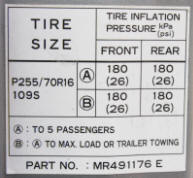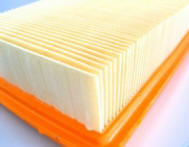Keep Your Engine Properly Tuned
 Fixing
a car that is noticeably out of tune or has failed an emissions test can improve its gas mileage by an average of 4 percent, though results vary based on the kind of repair and how well it is done.
Fixing
a car that is noticeably out of tune or has failed an emissions test can improve its gas mileage by an average of 4 percent, though results vary based on the kind of repair and how well it is done.
Fixing a serious maintenance problem, such as a faulty oxygen sensor, can improve your mileage by as much as 40 percent.
| Fuel Economy Benefit: | 4% |
|---|---|
| Equivalent Gasoline Savings: | $0.15/gallon |
Tune up tricks link
Keep Tires Properly Inflated
 You
can improve your gas mileage by up to 3.3 percent by keeping your tires inflated to the proper pressure. Under-inflated tires can lower gas mileage by 0.3 percent for every 1 psi drop in pressure of all four
tires. Properly inflated tires are safer and last longer. I usually add 5 psi more then recommended to get better mileage.
You
can improve your gas mileage by up to 3.3 percent by keeping your tires inflated to the proper pressure. Under-inflated tires can lower gas mileage by 0.3 percent for every 1 psi drop in pressure of all four
tires. Properly inflated tires are safer and last longer. I usually add 5 psi more then recommended to get better mileage.
The proper tire pressure for your vehicle is usually found on a sticker in the driver's side door jamb or the glove box and in your owner's manual. Do not use the maximum pressure printed on the tire's sidewall.
| Fuel Economy Benefit: | Up to 3% |
|---|---|
| Equivalent Gasoline Savings: | Up to $0.12/gallon |
Use the Recommended Grade of Motor Oil

You can improve your gas mileage by 1–2 percent by using the manufacturer's recommended grade of motor oil. For example, using 10W-30 motor oil in an engine designed to use 5W-30 can lower your gas mileage by 1–2 percent. Using 5W-30 in an engine designed for 5W-20 can lower your gas mileage by 1–1.5 percent. Also, look for motor oil that says "Energy Conserving" on the API performance symbol to be sure it contains friction-reducing additives. If you have a new car 0-20 is a great oil for you.
| Fuel Economy Benefit: | 1–2% |
|---|---|
| Equivalent Gasoline Savings: | $0.04–$0.08/gallon |
NEW INFORMATION: Replacing a Clogged Air Filter on Modern Cars Improves Performance but Not MPG

A new study![]() shows that replacing a clogged air filter on cars
with fuel-injected, computer-controlled gasoline engines does not improve fuel economy but it can improve acceleration time by around 6 to 11 percent.
This kind of engine is prevalent on most gasoline cars manufactured from the early 1980s onward.
shows that replacing a clogged air filter on cars
with fuel-injected, computer-controlled gasoline engines does not improve fuel economy but it can improve acceleration time by around 6 to 11 percent.
This kind of engine is prevalent on most gasoline cars manufactured from the early 1980s onward.
Tests suggest that replacing a clogged air filter on an older car with a carbureted engine may improve fuel economy 2 to 6 percent under normal replacement conditions or up to 14 percent if the filter is so clogged that it significantly affects drivability.
The effect of a clogged air filter on diesel vehicles will be tested in the near future.
Note: Cost savings are based on an assumed fuel price of $3.87/gallon.